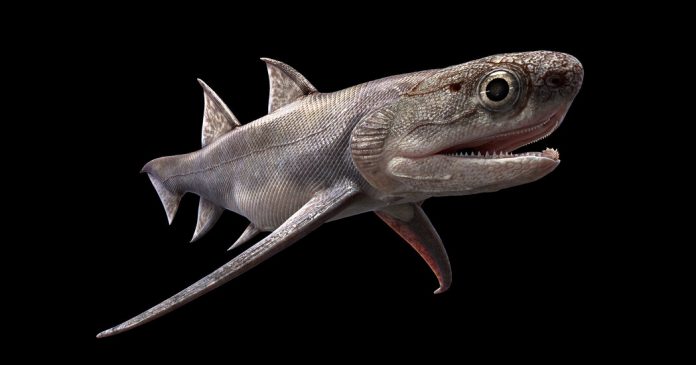Point out the ocean, and it’s exhausting not to think about jaws. The deep waters comprise many tooth-lined mouths: the bear-trap maws of sharks and dolphins, the slack lips of shoaling and reef fish, the baleen-filter gape of monumental whales. Jawed fish ultimately crawled out of the seas tens of millions of years in the past and gave rise to the jawboning vertebrates we’re at this time.
However when did such an evolutionary innovation come up? A pair of fossil beds found in Southern China recommend that the reply could lie tens of tens of millions of years deeper into the previous than beforehand thought. The findings — which embrace fantastically preserved new species of early fish, the oldest-known vertebrate enamel and lots of fish with armor — had been printed Wednesday throughout 4 papers in Nature.
“It is a step change in the place we’re enthusiastic about these occasions within the chronology of vertebrate evolution,” mentioned Matt Friedman, a paleontologist on the College of Michigan who was not concerned within the analysis however wrote a perspective article that accompanied the Nature papers.
Jawed fish explode into the fossil report 419-359 million years in the past throughout a interval often known as the age of fish, or the Devonian. Fish of this period all have “their identities clearly written on their our bodies,” mentioned Michael Coates, a paleobiologist on the College of Chicago who was not concerned within the new papers. They embrace historic teams like jawless fish, lineages of early jawed fish known as placoderms, ascendant newcomers like cartilaginous and bony fish and the primary fishes to hop onto land.
This sudden variety of jawed fish — additionally known as gnathostomes — has lengthy led scientists to suspect that their origins should lie deeper within the fossil report, a interval often known as the Silurian, mentioned Per Ahlberg, a paleontologist at Uppsala College in Sweden and an creator on one of many papers. However till just lately, the variety of helpful Silurian gnathostome fossils could possibly be counted on one hand.
A decade in the past, researchers got down to systematically survey the 425-million-year-old rocks of the late Silurian interval in China, mentioned Gai Zhikun, a paleontologist on the Chinese language Academy of Sciences and an creator on one of many papers. They had been rewarded with full fossils of early jawed fish.
Inspired, they delved into older rocks. In 2020 these fishing expeditions obtained a chunk: a pair of deposits outdoors of Chongqing.
The 2 fossil beds are separated by just a few million years in time, every with a special complement of species.
The 436-million-year-old mattress incorporates “little fishtank-sized fishes,” Dr. Ahlberg mentioned, only some centimeters lengthy, which signify the oldest-known full jawed fish. Most are of a flat, armored placoderm species named Xiushanosteus mirabilis, which probably lived on the seafloor. Additionally current is Shenacanthus vermiformis, a cartilaginous fish associated to sharks and rays, however with armor plates resembling these of unrelated placoderms — a discover that means early sharklike species retained the armor-plates current in earlier branches of the fish household tree.
Philip Donoghue, a paleontologist on the College of Bristol and an creator on one of many papers, says essentially the most outstanding specimen from the location is a jawless fish known as Tujiaaspis vividus. 1000’s of head shields from the species’ household are identified from the fossil report, however Tujiaaspis preserves the primary identified physique. It comes with a shock: a set of paired fins jutting out from the cranium, which Dr. Donoghue and his colleagues recommend is a possible precursor of the pectoral and pelvic fins present in gnathostomes, which for fish that moved onto land gave rise to legs and arms. Beforehand, researchers believed the 2 units of fins developed individually between jawless and jawed fish.
“It overturns typical knowledge on how paired appendages originated,” Dr. Donoghue mentioned.
The second web site, at 439 million years previous, preserved extra vital fossils. One paper describes a set of spines, scales and head-plates from an animal named Fanjingshania renovata, all of them dead-ringers for later examples of cartilaginous fish. One other information a whirl of related enamel — the oldest but identified from a vertebrate — from a fish named Qianodus duplicis. Each animals belong firmly to the department of jawed fish known as the chondrichthyans, the group of cartilaginous fish that embrace trendy sharks, rays and ratfish. (Bony fish like salmon and people are the opposite department.)
The presence of shark family on the web site means that the break up between cartilaginous and bony fish had already occurred by the early Silurian, Dr. Friedman mentioned. Taken collectively, each websites push the origin of vertebrate jaws and enamel again by virtually 14 million years.
“It’s an enormous shift from the consensus chronology,” Dr. Friedman mentioned, which can drive a drastic reconsideration of early marine ecosystems.
Jawed fish now appear to have originated as early because the Nice Ordovician Biodiversification, a interval round 485 million to 445 million years in the past when marine invertebrates dominated. The few identified fish from that interval are jawless and customarily unprepossessing, Dr. Coates mentioned. “They appear like armor-plated tadpoles,” he mentioned. “So the very last thing you’d count on is for proto-sharks and proto-bony fish to be swanning round on the identical time.”
As paleontologists proceed to dig deeper into early Silurian rocks in China, they’ve uncovered much more fish species. In the case of the earliest jawed fish, researchers could quickly discover that they’ll want an even bigger boat.
“It’s extremely probably that there shall be extra discoveries,” Dr. Ahlberg mentioned. “It’s an overused phrase, however I imply it: This guarantees to fully revolutionize our understanding of the earliest part of jawed vertebrate evolution.”


